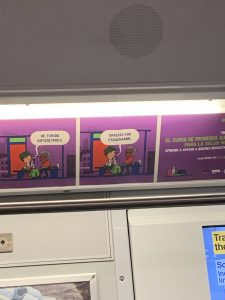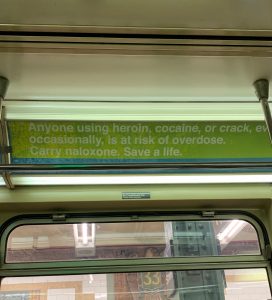Walking around in New York City, I couldn’t help but feel as though it is a near-perfect location for this essay. The city is multilingual (to the Nthdegree!) and takes pride in its melting pot of cultures. From Korean to Italian to Spanish to Chinese, New York offers the many opportunities for examples of different languages necessary for this essay. I also made sure to not neglect English, as it is, of course, the primary language of the city, and most of the signs posted around the city are in English. I have decided to look more specifically at how Spanish is used in New York, as I recognized there is a greater, stronger connection between New York City and Spanish than New York City and the other “secondary” languages spoken there, such as Chinese or Italian.
Spanish is all over the place in New York, and, frankly, challenges English in certain areas for being the primary language used. In the subway system, for example, I have noticed that there are a lot of signs in Spanish. Some of these signs are safety warnings, such as signs that encourage people to reach out for help when having mental health crises or encouraging them to carry naloxone, a drug that helps overdose victims. I would consider these signs to be “required” to be in multiple languages, as they are necessary for the public health and safety of the city. However, I would like to note that these types of signs are only in English and Spanish, indicating further the prevalence of Spanish and Hispanic culture in New York City. This is effectively promoting Spanish to the level of “primary language”, as it is considered absolutely paramount that there be safety signs posted in Spanish. Additionally, there are many advertisements around the city that are posted in Spanish, and I always trust that businesses are primarily concerned with maximizing the public’s awareness of them. Thus, considering the prevalence of Spanish language advertising, it stands to reason that Hispanic culture is relevant enough in New York City to warrant companies spending extra money in order to capture Hispanic peoples’ business.
This can be related with the Leeman and Modan article in that like Washington DC’s Chinese community, the Hispanic community of New York City became important enough to garner attention from companies run by people who are not of the same background as those communities. In Leeman and Modan’s article, they wrote about the second wave of gentrification in Washington DC’s Chinatown, and in particular the active decisions made to redesign Chinatown to look more aesthetically distinct from the rest of the city. They wrote, “Of particular interest for scholars of LL are the guidelines concerning language: Signage and Chinese characters are important design elements. Liberal use of Chinese characters in signage and decoration will provide needed Chinese ambiance in Chinatown” (Leeman and Modan, pg. 347). Vitally, it was an active decision made by the municipal government of Washington DC as well as the businesses that populated DC’s Chinatown that fostered the city’s unique Chinese identity. Similarly, it is an active decision by both the municipal government of New York City and the businesses that advertise on the subway to use Spanish. Additionally, one could even argue that New York’s use of Spanish makes a larger statement than Washington DC’s use of Chinese because Washington DC only utilized the Chinese language in a particular section of the city, where only a limited number of people in the city are exposed to the language. The subway system, on the other hand, runs throughout the entirety of New York City and, according to www.ny.com, 4.3 million people ride the New York City subway on a daily basis.
For a city so proud of its multilingual identity as New York, there remains a dominant presence of English as the main language. However, as time goes by, there will likely be an equivalence made between the use of Spanish and the use of English in the city, as the New York Hispanic community is a population that is only going to grow from here.


I definitely think that the prominent use of Spanish alongside English is very valuable, especially in the context of public safety signs like you mentioned on the subway. In my work place, we make a lot of informaitonal fliers about healthy eating and the use of public assistance benefits at the farmers market in English and Spanish primarily (with some in Mandarin and Bengali as well). Although most people seem to take the English fliers, there are a significant amount of people who take the exclusively Spanish fliers as well. I’m curious to see how the linguistic landscape changes in New York City in upcoming years and wether it will shift more towards Spanish like you suspect.
Really interesting that even in such a heavily multi-lingual place like NYC that there is so little multi-lingual signage. I’m sure this varies some depending on which part of NYC you’re in but I think it really is telling that English is so dominant in signage in public spaces, wonder when it will shift and what languages it will shift to.